THE FOURTH GENERATION
2000 until 2015
In 1997, the Wartmann Group’s last family shareholder stepped down from his operational function and the company’s original focus on the construction industry has taken a backseat to other activities, such as real estate, fuel, and technology. From the year 2000 onwards, the board of administration has been supported by external specialists. In 2002, the first representative of the fourth generation assumed his mandate on the Wartmann Group’s board of administration. In the wake of another generation change, leadership over the family company was transferred to the fourth generation. In 2010, for the first time, a representative of the fourth generation took over the Wartmann Holding AG’s chairmanship.
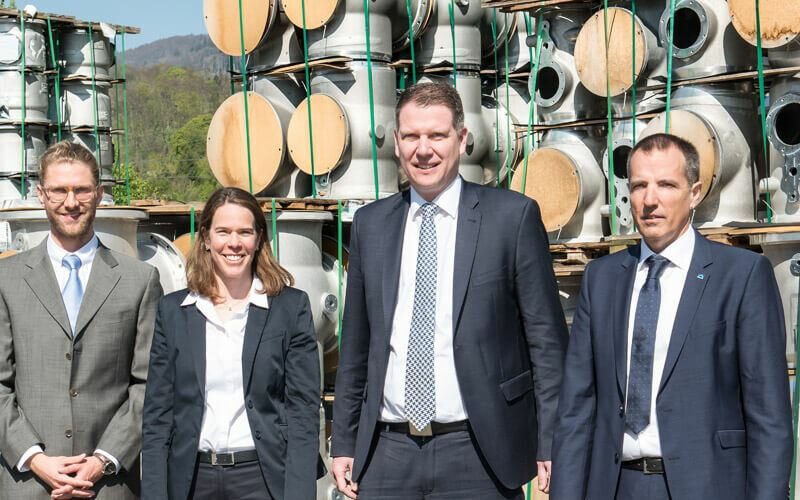
Board of administration – 4th generation
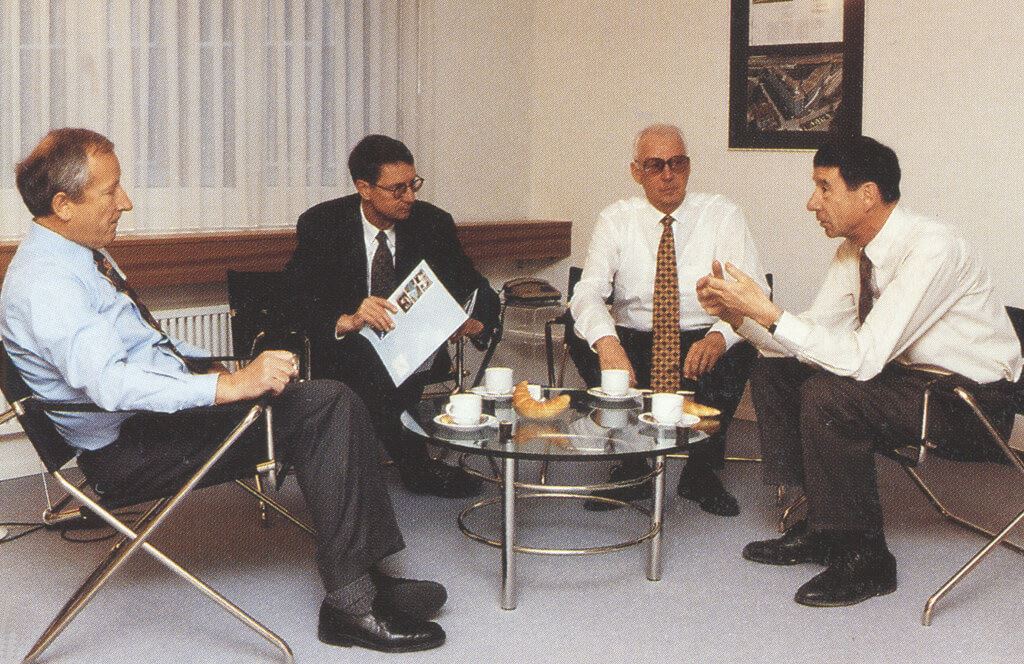
Paul Ramseier, Thomas Wartmann, Urs Wartmann and Beat Wartmann
THE THIRD GENERATION AND THE SECOND REMODEL
1971 until 1999
During the 1970s, a profound structural change took place in the Swiss steelwork and engineering industry since it suffered from the increasing competitive capacity of concrete, which led to a rapid price erosion. Recessive tendencies accelerated this development so that the shareholders decided to back out of the steelwork industry. Consequently, the shares in Zschokke Wartmann AG were sold and any steelwork activity at Wartmann AG in Oberbipp was abandoned. After almost 90 years of such activity by the Wartmann Group, this had been a difficult decision to make for everyone involved. Over the course of the third generation change, a new holding structure was introduced in 1976, in which all the Wartmann Holding AG’s investments were combined. In 1977, the administrative board consisted of Rudolf Wartmann (Jr.)’s three sons, as well as Paul Ramseier, thus finalising the generation change. From 1975 onwards, the company’s property portfolio was advanced, resulting in the newly founded subsidiary Wartmann Immobilien AG.
FIRST REMODEL
1951 until 1970
The company’s spatial conditions became more cramped and necessary rationalisation measures, such as the adjustment of production processes or the introduction of new machinery and procedures, became more problematic. In view of the generation change on the horizon, some family members of the third generation stepped up to (responsible) management positions. These circumstances, as well as bigger and more complex jobs, caused the dissolution of the production site in Brugg, and led to the sale of the vacated premises. Instead, Zschokke Wartmann AG was founded as a result of a merger with the former competitor AG Conrad Zschokke, which had run smoothly. As a consequence, sensible investment alternatives, such as the storing of fuel oil, were explored. In 1969, the Tanklager Oberbipp AG, a fuel depot for domestic fuel and all associated services, was founded. The end of the 1960s was marked by various structural adjustments to the facilities in Brugg and Oberbipp.
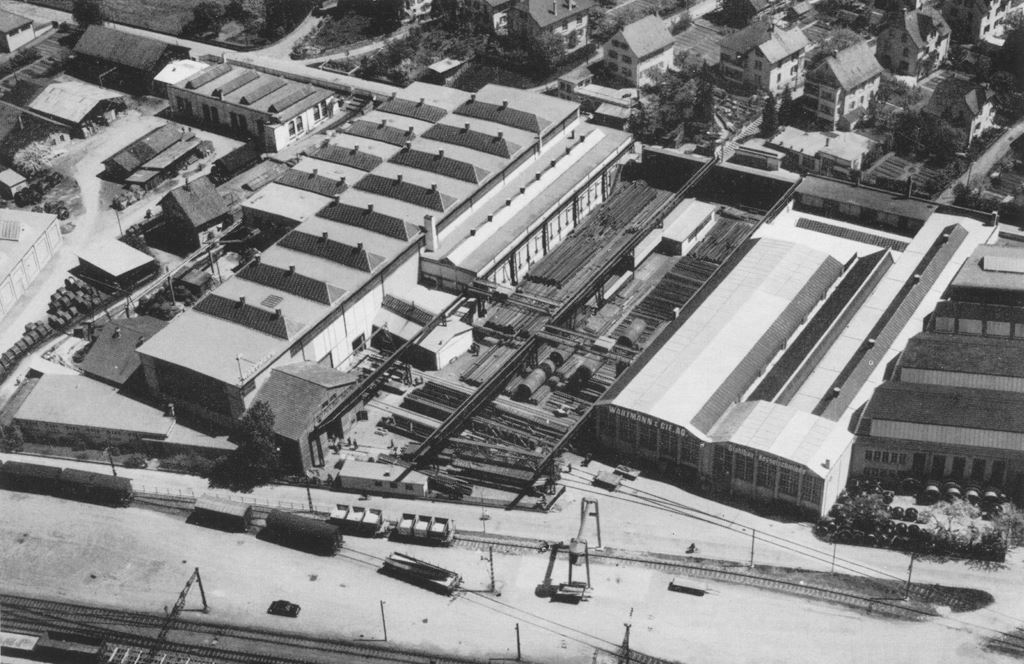
Aerial view of the workshop in Brugg
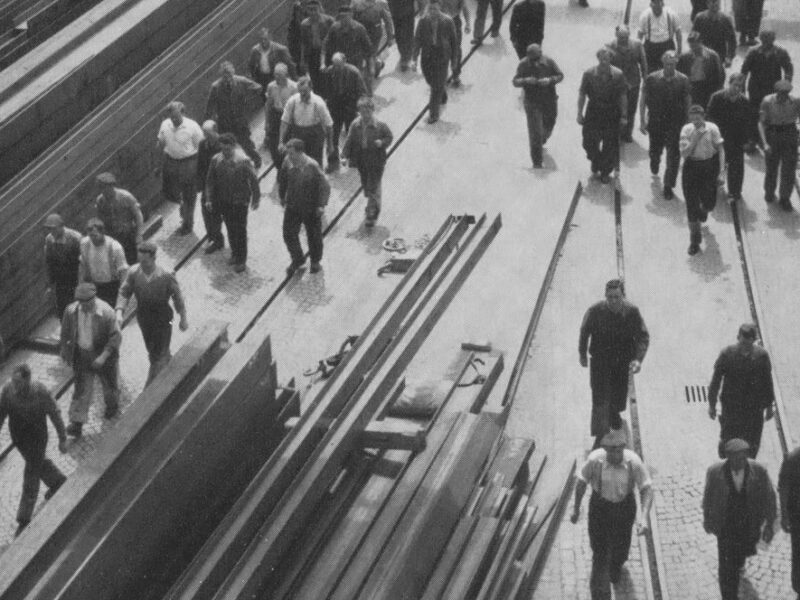
Start of work
DEVELOPMENT
1942 until 1950
It was not until the forties when positive change arrived and the company started expanding; in 1942, they moved into a new headquarter in Brugg and the remodelling of the workshop was finalised. It was now equipped, amongst other things, with the tools to repair warravaged French freight wagons. After the Second World War, a subsidiary dealing with steel welding technology, the steel welding company Wartmann AG, was founded. Benefitting from a continuing economic boom, the company was developing excellently, both in terms of technical and operational capacity. Soon enough it was heading the steel welding industry.
THE SECOND GENERATION
1931 until 1941
After the founder’s death, his two sons, Rudolf Wartmann (Jr.) and Armin Wartmann, became shareholders with unlimited liability, as well as members of the directorate. In addition, Bernhard Lauterburg and Paul Kühling joined Wartmann & Cie., as the company was called henceforth, as associates. Initially, the young directorate was heavily tested since the economic crisis of the 1930s brought with it deficits. Furthermore, the mobilisation in 1939 paralysed business since half of the staff had to report for military duty and the procurement of materials from foreign companies was halted.
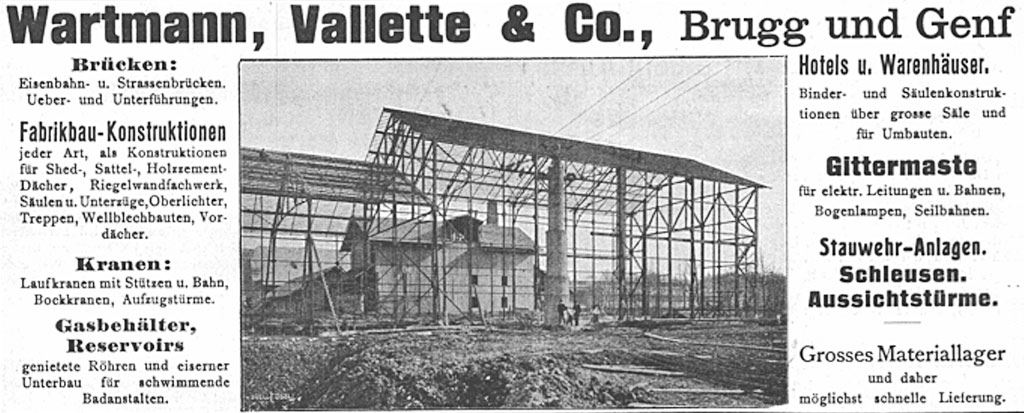
Newspaper advertisement Wartmann, Vallette & Co.
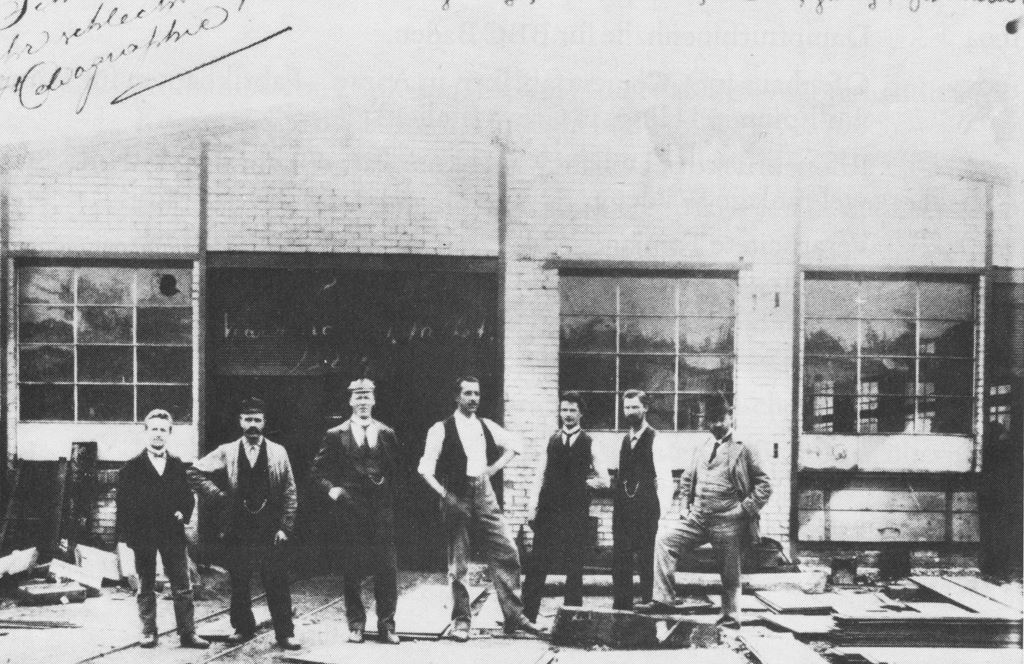
Workers in front of the factory
ESTABLISHMENT
1896 until 1930
When he was 22 years old, Rudolf Wartmann (Sen.) started working as a joint partner in a small steelwork factory near the train station in the Swiss town of Brugg. This event in 1896 is regarded as the birth of the family business Wartmann. Three years later, Rudolf Wartmann (Sen.) was already taking over the business, joining forces with his friend A.E Vallette. The accelerated electrification of the Swiss Federal Railways brought the steel construction companies a lot of interesting orders. After a 30-year build-up phase, the two pioneers reached the peak of their economic success in 1929, and the company became the thirdlargest steel construction company in Switzerland. They were even able to endure the difficult economic times during the First World War, as well as fluctuations in iron prices. However, Rudolf Wartmann (Sen.) passed away in 1930, without having initiated his successor into the family business. At the same time, his partner Vallette left the company. As a consequence of guarantees granted by the company, as well as an occasionally disadvantageous course of business, the company came under increasing financial strain.
History
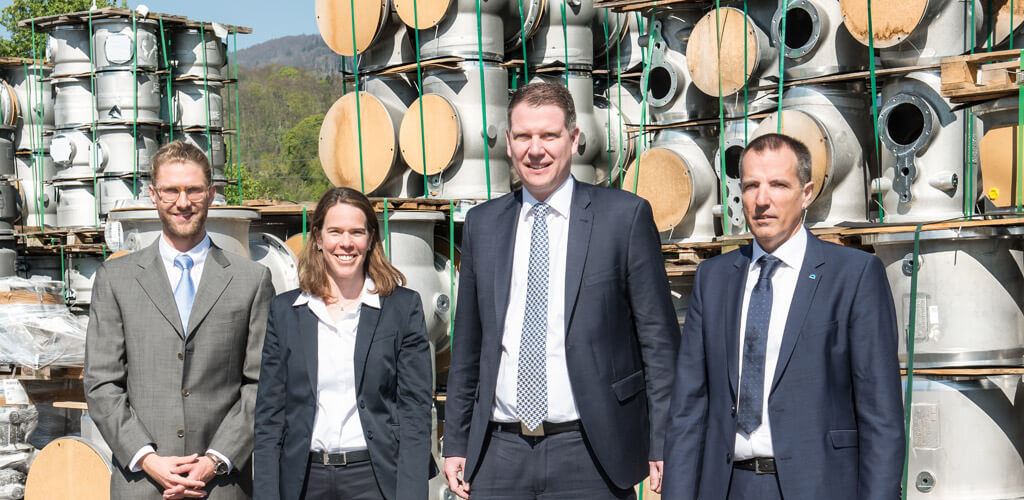
Board of administration – 4th generation
THE FOURTH GENERATION
2000 until 2020
In 1997, the Wartmann Group’s last family shareholder stepped down from his operational function and the company’s original focus on the construction industry has taken a backseat to other activities, such as real estate, fuel, and technology. From the year 2000 onwards, the board of administration has been supported by external specialists. In 2002, the first representative of the fourth generation assumed his mandate on the Wartmann Group’s board of administration. In the wake of another generation change, leadership over the family company was transferred to the fourth generation. In 2010, for the first time, a representative of the fourth generation took over the Wartmann Holding AG’s chairmanship.

Paul Ramseier, Thomas Wartmann, Urs Wartmann and Beat Wartmann
THE THIRD GENERATION AND THE SECOND REMODEL
1971 until 1999
During the 1970s, a profound structural change took place in the Swiss steelwork and engineering industry since it suffered from the increasing competitive capacity of concrete, which led to a rapid price erosion. Recessive tendencies accelerated this development so that the shareholders decided to back out of the steelwork industry. Consequently, the shares in Zschokke Wartmann AG were sold and any steelwork activity at Wartmann AG in Oberbipp was abandoned. After almost 90 years of such activity by the Wartmann Group, this had been a difficult decision to make for everyone involved. Over the course of the third generation change, a new holding structure was introduced in 1976, in which all the Wartmann Holding AG’s investments were combined. In 1977, the administrative board consisted of Rudolf Wartmann (Jr.)’s three sons, as well as Paul Ramseier, thus finalising the generation change. From 1975 onwards, the company’s property portfolio was advanced, resulting in the newly founded subsidiary Wartmann Immobilien AG.

Aerial view of the workshop in Brugg
FIRST REMODEL
1951 until 1970
The company’s spatial conditions became more cramped and necessary rationalisation measures, such as the adjustment of production processes or the introduction of new machinery and procedures, became more problematic. In view of the generation change on the horizon, some family members of the third generation stepped up to (responsible) management positions. These circumstances, as well as bigger and more complex jobs, caused the dissolution of the production site in Brugg, and led to the sale of the vacated premises. Instead, Zschokke Wartmann AG was founded as a result of a merger with the former competitor AG Conrad Zschokke, which had run smoothly. As a consequence, sensible investment alternatives, such as the storing of fuel oil, were explored. In 1969, the Tanklager Oberbipp AG, a fuel depot for domestic fuel and all associated services, was founded. The end of the 1960s was marked by various structural adjustments to the facilities in Brugg and Oberbipp.

Start of work
DEVELOPMENT
1942 until 1950
It was not until the forties when positive change arrived and the company started expanding; in 1942, they moved into a new headquarter in Brugg and the remodelling of the workshop was finalised. It was now equipped, amongst other things, with the tools to repair warravaged French freight wagons. After the Second World War, a subsidiary dealing with steel welding technology, the steel welding company Wartmann AG, was founded. Benefitting from a continuing economic boom, the company was developing excellently, both in terms of technical and operational capacity. Soon enough it was heading the steel welding industry.

Newspaper advertisement Wartmann, Vallette & Co.
THE SECOND GENERATION
1931 until 1941
After the founder’s death, his two sons, Rudolf Wartmann (Jr.) and Armin Wartmann, became shareholders with unlimited liability, as well as members of the directorate. In addition, Bernhard Lauterburg and Paul Kühling joined Wartmann & Cie., as the company was called henceforth, as associates. Initially, the young directorate was heavily tested since the economic crisis of the 1930s brought with it deficits. Furthermore, the mobilisation in 1939 paralysed business since half of the staff had to report for military duty and the procurement of materials from foreign companies was halted.

Workers in front of the factory
ESTABLISHMENT
1896 until 1930
When he was 22 years old, Rudolf Wartmann (Sen.) started working as a joint partner in a small steelwork factory near the train station in the Swiss town of Brugg. This event in 1896 is regarded as the birth of the family business Wartmann. Three years later, Rudolf Wartmann (Sen.) was already taking over the business, joining forces with his friend A.E Vallette. The accelerated electrification of the Swiss Federal Railways brought the steel construction companies a lot of interesting orders. After a 30-year build-up phase, the two pioneers reached the peak of their economic success in 1929, and the company became the thirdlargest steel construction company in Switzerland. They were even able to endure the difficult economic times during the First World War, as well as fluctuations in iron prices. However, Rudolf Wartmann (Sen.) passed away in 1930, without having initiated his successor into the family business. At the same time, his partner Vallette left the company. As a consequence of guarantees granted by the company, as well as an occasionally disadvantageous course of business, the company came under increasing financial strain.

